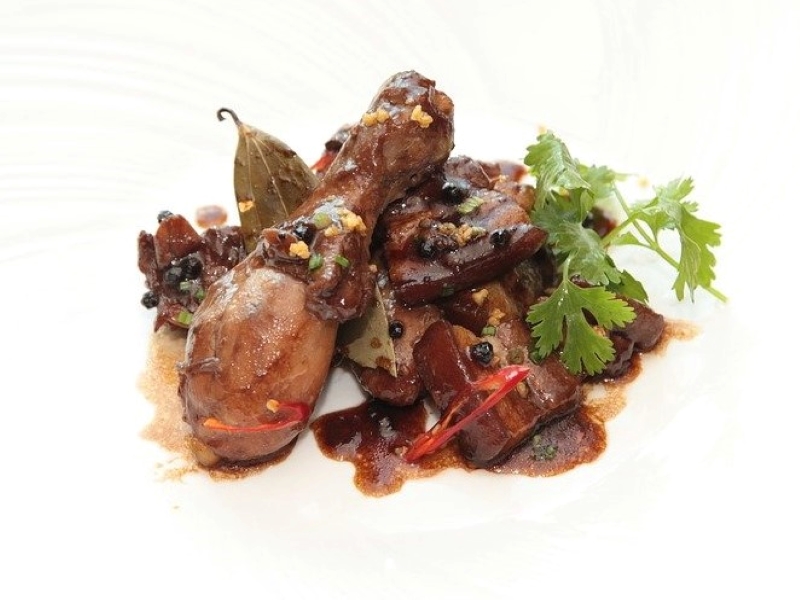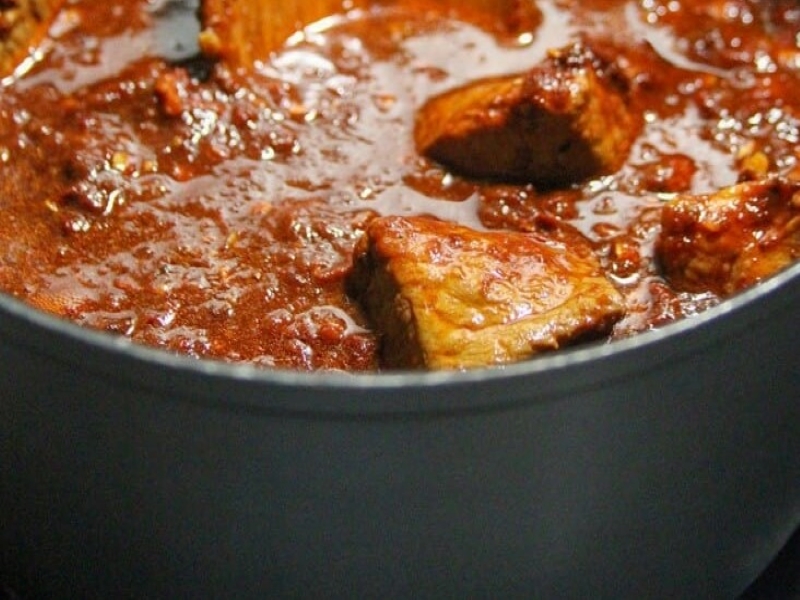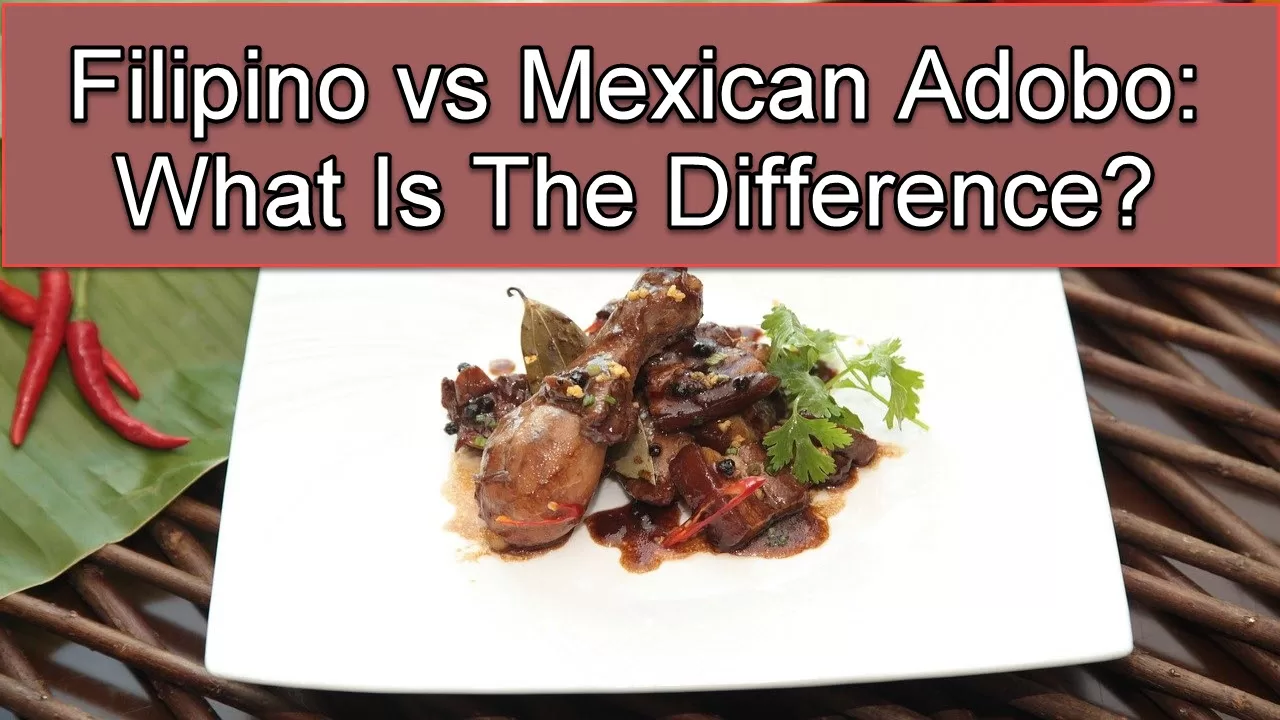What is an Adobo?
Adobo is derived from the Spanish word adobar, meaning “to marinate”. Adobo is the immersion of cooked food in a sauce, usually made of oregano, salt, soy sauce, garlic, paprika, and vinegar to preserve and add flavor to the food. Its Portuguese variant is known as Carne de vinha d’alhos. Adobo is native to Iberia.
Adobo became popular and has spread throughout Latin America, and Spanish and Portuguese communities in Africa and Asia.
Initially, adobo was created as a practice of preserving food. With the rise of refrigeration methods, adobo is now used as a procedure of flavoring foods before cooking. Adobo can refer to a sauce, a whole dish, or a seasoning.
Today, there are a lot of variations of Adobo. There’s a Puerto Rican adobo, Peruvian adobo, Spanish adobo, Mexican and Filipino adobo. The cooking method varies widely by region. Let us learn more about the Mexican and Filipino adobo, and their main differences.
Filipino vs Mexican Adobo

Filipino Adobo
Adobo is a popular Filipino food in the Filipino cuisine. The cooking process involves meat, such as pork or chicken, seafood, or vegetables. The primary ingredients are marinated in soy sauce, vinegar, bay leaves, garlic, and black peppercorns. The dish in browned in oil, and cooked in the marinade.
Adobo is viewed as the unofficial national dish in the Philippines.
There are several variant of Filipino adobo recipe, but the most common ingredient is the vinegar. Vinegars such as coconut vinegar, rice vinegar, or can vinegar can be used.
Usually, pork and chicken are the main ingredients in preparing a Filipino adobo. It can also be a combination of pork adobo and chicken adobo, and usually served with steamed rice. For Muslim Filipinos, beef is usually used in preparing adobo.
Other variants of adobo include fish, shrimp, catfish, and squid. There are also adobo versions of vegetables and fruits, such as water spinach or “adobong kangkong”, bamboo shoots, or “adobong labomg:, eggplant or “adobong talong”, okra or “adobong okra”, and banana flowers or “adobong puso ng saging”.
A unique and rare version of Filipino adobo is the white adobo or “adobong puti”. It uses salt instead of using the traditional version, soy sauce. White adobo is almost similar to the original version of the Pre-Hispanic adobo.
History of Filipino Adobo
Philippine adobo is an indigenous dish in the Philippines. When Spain colonized the Philippines in the late 16th century and early 17th century, they came across a cooking method that involved stewing with vinegar.
Pre colonial Filipinos frequently prepared or cooked food with salt and vinegar to preserve and keep the food fresh longer in the climate of the Philippines. One of the most essential ingredients in Philippine cuisine is vinegar. The Spanish called this cooking method as adobo because it is similar to the Spanish adobo. Spanish adobo comes from the Spanish word “adovar” meaning to marinate.
In 1613, this was documented in the dictionary, Vocabulario de la lengua tagala (dictionary of Tagalog language in the Philippines) by Pedro de San Buenaventura, a Spanish Franciscan missionary. He called it as adobo de los naturales, meaning adobo of the native peoples.
Food cooked with garlic, vinegar, salt, soy sauce and other spices, eventually known as adobo.
Filipino Adobo Flavor
Philippine adobo has a salty and sour taste, and often has a sweet taste. Filipino adobo does not have paprika, chilis, oregano, or tomatoes. The only similarity with Spanish adobo is the use of garlic and vinegar.

Filipino Pork Adobo Recipe
Ingredients:
- 2 lbs pork belly, cut into small pieces
- 3 gloves chopped garlic
- 2 tbsp vegetable oil (you can use olive oil)
- 1/3 cup white vinegar
- 1/3 cup soy sauce
- 2 bay leaves
- ½ tsp ground pepper/ black peppercorns
- 1 cup water
- 1 tbsp brown sugar
Cooking Method
- Heat oil in a large pan or wok. Add pork belly pieces, and cooked until meat is golden brown.
- Next, add garlic and sauté. Add soy sauce, white vinegar, pepper, bay leaves and water.
- Then, boil the meat. Simmer for 30 to 45 minutes or until pork is tender. Cover with a lid. Check the adobo from time to time. Make sure it doesn’t dry out. Add 1/2 cup of water or as needed until pork is tender, and the preferred amount of adobo sauce has achieved.
- Serve with steamed rice.

Mexican Adobo
Mexican adobo is considered a cooking sauce or condiment. The sauce is thick, red, and spicy. This sauce is used as a marinade to enhance flavor, as well as add a spicy flavor.
Mexican adobo is generally used as a marinade for seafood and meat.
When you use it as a marinade, it goes well on grilled meat. As a sauce, it can be used to simmer meat. Mexican adobo utilizes the traditional Spanish spices, and adds native ingredients such as tomatoes and chilies.
History of Mexican Adobo
Mexico was colonized by Spain for 300 years.
Mexican adobo sauce is made up of dried chiles like guajillo and ancho peppers. These chiles are rehydrated and mixed into a thick paste with vinegar or citrus juice. Onions, garlic, cumin, and oregano are also added.
It has a Spanish influence, since it uses traditional spices from Spain. Therefore, Mexican adobo is a combination of local and colonial influences.
Mexican Adobo Flavor
Mexican adobo is spicier compared to Filipino adobo. It is sometimes infused with oregano.

Mexican Pork Adobo Recipe
Ingredients
- 2 lbs pork belly or pork shoulder, cut into cubes
- 12 ancho chiles (dried)
- 3 guajillo chiles (dried)
- 2 chopped tomatoes
- 1 small onion, chopped
- 4 cloves of garlic
- 1/4 cup cider vinegar
- 1 tablespoons oregano (dried)
- 1 teaspoon cinnamon
- 1/4 teaspoon ground cloves
- 1 tablespoon olive oil or canola oil
- 1 1/2 cups water
- salt and black pepper to taste
Cooking Method
1. In a pan over medium heat, add chiles and roast for about 20 to 30 seconds. Roasting the anchos and guajillios reveal the natural flavors, and adds a hint smokey flavor.
2. Remove roasted chiles from pan and place in a bowl with enough hot water for them to soak and hydrate. Soak for about 20 minutes. Make sure to cover the bowl.
3. Mix chiles, onion, tomato, vinegar, garlic, cinnamon, oregano, cloves, brown sugar, salt and pepper in a blender. Blend until you achieve thick paste consistency. Set aside.
4. Heat oil in a thick-bottomed pot. Add pork and cook, until golden brown. Remove the oil from the pan.
5. Then, add chili paste and mix together to fully coat the pork.
6. Add water, and simmer.
7. Lastly, lower the heat, cover with a lid, and cook for about 2 hours or until meat is tender. Add salt to enhance flavor.

